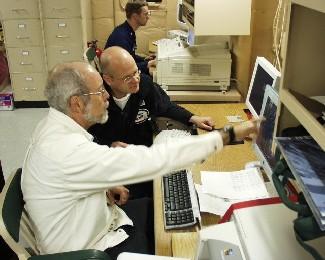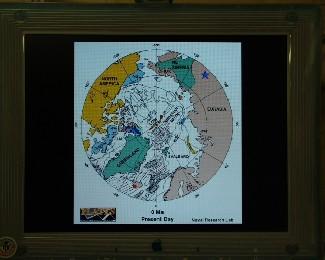23 June, 2000
23 June 2000
Our Puzzling Planet
Plate tectonocist you ask? That was the term I finished yesterdayís
journal with, describing Dr. Larry Lawver of the University of Texas at
Austinís Institute for Geophysics. Dr. Lawver studies plate tectonics, the
movement of the earthís crustal plates. Many students are at least somewhat
familiar with this process, but for those of you that arenít, here is a
somewhat brief introduction.
The earthís crust is a relatively thin layer of solid rock that essentially
floats on the molten mantle below it. This rocky layer is made up of a
collection of interconnecting plates of varying sizes. Movement of the
magma in the mantle causes the plates to move, and where plates meet, one of
several things can happen. The process that generates much of the movement
occurs where plates spread apart due to new magma pushing its way to the
surface and pushing the plates out as it forms new crust. This most often
takes place underwater where the crust is thin and results in mid-ocean
ridges and rift valleys at locations known as sea-floor spreading zones.
This process continues to spread South America and Africa apart. Closer to
where we are, the same process keeps increasing the distance between
Greenland and Scandinavia. Nearby Iceland is one of the few places where a
spreading zone goes through land.
When plates are pushed together, either one plate will be pushed under the
other or they will be piled up against each other. If one plate is pushed
under another plate, known as subduction, the oceanic crust sinking into the
mantle takes water with it lowering the melting point of the granite above
it. This new magma often comes up as volcanoes. This process formed the
volcanoes of the Cascade Range, such as Mt. Rainier in Washington, Mt. Hood
in Oregon and Mt. Shasta in California. If both plates are under water when
subduction occurs, the resulting volcanoes often form an island arc such as
the Aleutian Islands of Alaska. If the plates pile up, large mountain
ranges such as the Himalayas are formed.
Plates may also slide along each other where their edges meet. These areas
are known as transform boundaries and are characterized by abundant
earthquakes. These slipping and sliding zones can often be identified by
the presence of large fault lines. The San Andreas fault is a good example
of this feature.
As you should begin to see, the surface of our planet is like a dynamic
jigsaw puzzle, where the pieces are not just constantly moving around, but
also changing in size. As these pieces move, the landmasses that jut out of
the ocean on top of them are moved around with them. The movement of these
landmasses is known as continental drift. Most middle school or high school
earth science classes deal with the big pieces of the puzzle. The links
between major masses, especially South America and Africa, are quite
evident. It is all the little pieces of the puzzle that researchers are
still trying to piece together and trace to their past locations during our
planetís history.
This is what Dr. Lawver spends his time studying. Evidence of past
movements can be found in the rocks of the continents themselves, but
direction and rate of movement can most readily be found in the rocks
created during sea floor spreading. As the magma from these zones cool,
their magnetic direction is set. You may not be aware of it, but the
magnetic pole of our planet flip-flops episodically and this magnetic change
is reflected in igneous rocks. These changes in direction are called
magnetic anomalies. By looking at these anomalies around spreading zones,
researchers can see when the rock was formed and determine how fast various
zones were spreading. This lets someone like Dr. Lawver backtrack the
position of continents over time.
Todd and I were able to see several simulations Larry and his associates
have put together that show the movement some of the pieces over time. It
is fascinating to see all the pieces move and change - a virtual geologic
ballet, and to see the origins of what we may see today as a single piece of
land. Among the most interesting areas to see for me, was the construction
of the state of Alaska from hundreds of bits of continental crust.
One thing Dr. Lawver pointed out on his animations was where there were not
any magnetic anomalies evident. One location where this occurs is in the
Gulf of California where he did his doctoral research, and another is Baffin
Bay where we are now. These areas both show evidence of spreading, but
their spreading zones are buried under so much sediment that the new magma
just forms a layer underneath the sediments as it solidifies. This is
because the sediments insulate the magma, slowing its cooling, compared to
when it comes up directly into the water at the bottom of the ocean. When
the next layer is formed, it cools above the previous layer, and so on, and
so on, until you have a layer cake of igneous rock under the sediments. The
magnetic story is then trapped under the upper-most layer rather than
spreading out from the diverging boundary. This is where Larry uses
information contained in the cores discussed in the past couple journals to
deduce where the spreading zones are, and how fast they might be spreading.
He accomplishes this by sticking needle-like probes into the cores to
measure thermal conductivity with depth and he measures the thermal gradient
through the core with a different type of probe. Thermal Gradient and
Thermal Conductivity are multiplied to calculate heat flow, which relates to
how long ago the sediments were heated by magma below them. This
information helps fill in some of the missing puzzle pieces left by the
magnetic anomaly data. All of it together allows a geophysicist/plate
tectonocist/master-puzzle-solver like Dr. Lawver begin to piece together our
earthís geologic history and possibly predict some of its future.

The arctic basin 55 million years ago. Greenland and Scandinavia close together in lower right.

Dr. Larry Lawver shows Todd some of the features of his plate tectonic simulation.

The arctic basin 7 million years ago. Lines between Greenland and Scandinavia are magnetic anomalies. Iceland forming in between at hot spot and spreading zone.

The arctic basin as it is today.
Contact the TEA in the field at
.
If you cannot connect through your browser, copy the
TEA's e-mail address in the "To:" line of
your favorite e-mail package.
|
